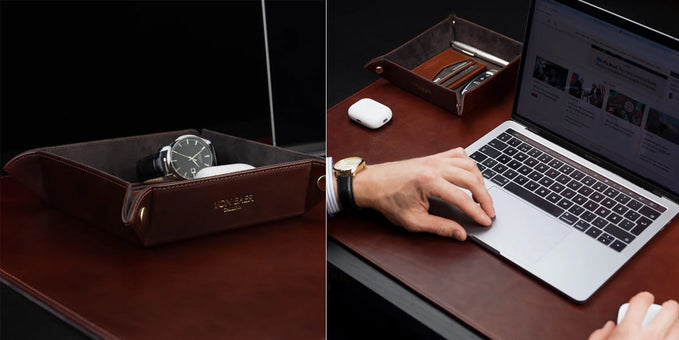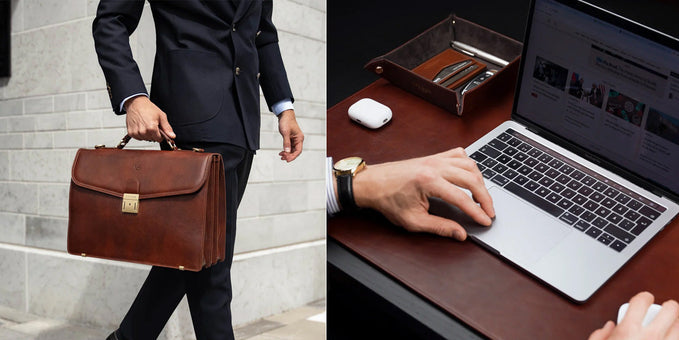How to soften leather

Leather ranks among the most fashionable and adaptable textiles on Earth.
If leather is not given proper care, it can gradually lose its flexibility and become rigid.
This results in reduced comfort and an increased risk of developing cracks, which is undesirable.
It's also quite common for specific varieties of leather to lose their flexibility over time.
Read on to find out the best ways to soften leather.
5 Methods to Soften Leather

Don't give up on your beloved leather item just yet.
Assess the current state of the leather. It may be beyond salvageable if it has become extremely stiff to the point of cracking or breaking.
However, if it has simply accumulated dirt and remained idle for some time, there are various methods to rejuvenate it.
While some of these techniques may require a couple of days to show their full impact, you can ultimately restore the item's smoothness and flexibility.
1st Method: Natural Oils
When it comes to softening leather, natural oils are an excellent choice.
Opt for oils like jojoba, coconut, or avocado to achieve the desired softness in your leather items.
Before applying any natural oil, it's beneficial to expose the leather to sunlight, especially during the summer, as this helps open the pores and facilitate the absorption process.
Here's a step-by-step approach for using natural oils to soften leather:
- Select one of the recommended natural oils. Look for oils that are not chemically hydrogenated and preferably derived from vegetables or corn, as they have skin-softening properties.
- Apply the oil onto the leather item. Dip your finger in the oil, then gently rub it into the leather. For optimal results, apply numerous layers of oil, allowing each layer to dry before applying the next. This not only increases softness but also enriches the color of the leather.
- If you're not satisfied with the initial outcomes, feel free to repeat the process. Ensure that the oil is evenly applied to avoid any uneven coloration. By following the proper technique, you can achieve a softer and more comfortable leather garment.
It's always advisable to test the oil's effects on a small and unnoticeable area of the leather before applying it to the entire item. Massage a small amount of oil onto the test area and observe for any discoloration or adverse reactions. If the oil causes discoloration, refrain from using it to soften your leather.
Remember, natural oils can work wonders in softening leather, but it's essential to exercise caution and follow the appropriate guidelines to ensure the best results.

2nd Method: Softening by Heating
Since leather goods are crafted from animal hide, they respond in a similar manner to our own skin.
Just as we use moisturizer on our skin to enhance its softness, the same principle applies to leather purses, wallets, and backpacks.
However, caution must be exercised when utilizing heat as a method to soften leather clothing items. It is advisable not to apply heat to newer goods, as it may cause any residual moisture to evaporate, potentially leading to further damage.
Before resorting to heat, it is recommended to apply a moisturizer and gently rub it into the leather.
Here are a few techniques you can employ to soften your leather accessories:
Hair Dryer Method
Use a hair dryer after applying moisturizer to your leather. Maintain a distance of approximately 15 cm between the hair dryer and the leather surface. Move the hair dryer back and forth, avoiding prolonged exposure to one area. This technique helps soften and brighten the leather.
Dryer Method
If you need quick results, you can put the leather garment in a dryer. Set the dryer to medium temperature and leave it for 10-15 minutes. Be cautious not to expose the leather to excessively high temperatures or leave it in the heat for too long, as it may scorch or shrink. Ensure that the leather item is either completely dry or slightly moist. Avoid washing leather apparel in a washer.
Humid, Warm Environment
To create a humid and warm environment, you can hang the leather accessory in the bathroom while taking a hot shower or place it under your car's windshield.
Allow it to stay there for a while, but be mindful of not subjecting it to direct heat for an extended period, as it may lead to the leather fading or drying out.
The shower method serves a dual purpose by softening the leather and allowing it to absorb moisture.
Remember, softening leather requires care and proper technique. By following these suggestions, you can help restore softness to your leather items effectively.

3rd Method: Water to Soften Leather
If you prefer to avoid using chemicals, you can soften leather by incorporating water into your leather care routine. The following simple methods can be employed:
- Fill a Spray Bottle with Water To moisturize and soften the leather item, fill a spray bottle with water and securely tighten the cap to prevent any accidental spills. If you want to avoid staining or mineral build-up caused by hard water, it is recommended to use distilled water rather than tap water. If a spray bottle is unavailable, a damp towel can be used as an alternative. Please note that water cannot soften leather that has been treated with waterproofing agents.
- Spray the Leather Surface Spray the water evenly on the entire surface of the leather item, starting from the top and working your way down. Continue spraying until you notice water droplets forming on the leather. Over time, the moisture will penetrate the leather, making it lose its stiffness. To facilitate the softening process, wear the leather item to allow it to conform to your body shape. Another option is to wear the leather while standing outside during a light drizzle. However, avoid exposing the leather to excessive moisture and do not stand in the rain for extended periods, as it may lead to saturation. Although a small amount of water can provide a slight aging effect to leather, excessive moisture should be avoided to prevent damage.
- Wipe off Excess Water by using a soft brush or a clean cloth. Afterward, gently wipe off any leftover water from the leather. Allow the item to air dry naturally in a cool and dry area. The remaining moisture will gradually evaporate. It is important to avoid leaving excessive water on the leather, as it can cause fading and damage, giving the garment an undesirable appearance. Make sure that all metal components are thoroughly dried to prevent them from becoming tarnished.
- Apply Conditioner After completing the softening process, apply a high-quality leather conditioner. Applying it correctly will aid in maintaining the leather's moisture and protect it from becoming fragile and dying out as time goes on.
By following these steps, you can effectively soften leather using water as a natural approach to leather care.
4th Method: Vaseline & Alcohol
If you don't have access to leather oils or a leather conditioner, don't worry. There are still ways to revive and soften your old, stiff leather item. Here's a method you can try:
Start by soaking a cotton pad, roughly around the same size as a credit card, with rubbing alcohol. Gently apply the pad all over the surface of the leather until you notice a slight shine. Take care to ensure an even application.
Next, apply a thin layer of Vaseline onto the leather's surface. If you feel that the leather will absorb more moisture. You can even consider adding multiple layers. To allow the Vaseline and alcohol to penetrate the leather and work their softening magic, leave the leather to dry overnight prior to using it.
By following these steps, you can breathe new life into your hardened leather object without the need for specialized leather oils or conditioners.
Related leather care guides:
- Repair cat scratches on leather
- Remove water stains from leather
- Clean leather wallet & remove stains/smells
- Remove ink from leather
- Get smell out of leather
- Remove stains from leather shoes
- Clean suede leather bag
- How to reform a leather bag
- How to maintain leather bags
- Repair cracked leather
- Wet leather
- How to clean leather bag
- How to restore faded leather bag
5th Method: Using Leather Conditioner
Achieve soft and supple leather by using commercially available leather conditioners, which offer the added benefit of strengthening the material. Follow these steps when applying leather conditioners:
- Purchase a High-Quality Leather Conditioner Invest in a reputable leather conditioner like leather honey conditioner or Lexol conditioner. These products contain oils that help lubricate the leather, causing it to bend and flex with your body effortlessly. Unlike some other oils, leather conditioners do not create a greasy appearance or reduce the longevity and quality of the material. Some conditioners are available in bundles, including neatsfoot oil, wax and leather milk.
- Apply a Small Amount of Conditioner onto a Clean Cloth. Squeeze a small quantity of leather conditioner onto a clean cloth. It's important to use only a modest amount of conditioner and avoid pouring it directly onto the leather, as this can cause cracking and uneven distribution.
- Gently apply the Conditioner to the Leather Surface using broad or circular strokes, gently apply the conditioner to the surface of the leather. Aim for a thin, even layer that imparts a subtle shine. Pay extra attention to areas such as the toes and ankles of boots or the elbows of jackets. Avoid overusing the conditioner, as excessive application can give the leather an oversaturated, overly moist appearance.
- Regularly Condition Your Leather Products To maximize the longevity of your leather items, it's recommended to condition them at least once a year. With each conditioning treatment, the leather becomes increasingly soft and flexible. For those residing in arid climates, conditioning leather products at least once monthly will help keep them soft and well-moisturized.
By following these steps and incorporating regular conditioning into your leather care routine, you can maintain the softness and durability of your leather items over time.
Choosing the Best Leather Conditioner
If homemade remedies prove ineffective, opting for a conditioner can yield better results. The challenging aspect lies in selecting the ideal leather conditioner that suits your specific needs.
Most creams and conditioners on the market contain lanolin as their primary ingredient. Some individuals discourage the use of spray conditioners due to their inclusion of water and cheap lubricants, which are employed to minimize production expenses.
We recommend the Von Baer Leather Cream, which is specifically designed for high-end leather bags and products.
Alternatively, you can explore the option of creating your own blend by utilizing natural beeswax and other organic oils. Refer to reliable "how-to" guides for detailed instructions on crafting your personalized leather conditioner.
What kinds of leather exist, and how does their stiffness vary?
Contrary to popular belief, leather does not solely originate from cowhide. It is not uncommon to find leather made from various animal hides such as elk, buffalo and ostrich.
Bovine leather, known for its toughness, is primarily used for protective purposes like motorcycle jackets.
Although it is delicate and fragile, it ages gradually. Goatskin, on the other hand, offers a great alternative to calfskin and bovine, combining softness with durability.
Notably, goatskin possesses excellent water-repellent properties, which sets it apart. High-end companies and luxury designers highly value lambskin leather.
Here is an overview of the most commonly used hides and their softness:
- Cowhide: Widely used in furniture due to its strength and durability, but less common in the fashion industry due to its toughness and heavy weight.
- Deerskin: Relatively prevalent and much softer than cowhide. The presence of air between its granules gives it a smooth texture. Deerskin leather also offers the unique ability to provide warmth in cold weather and keep cool in hot summers. It is highly durable and abrasion-resistant.
- Lambskin: The softest type of leather, derived from young animals, resulting in its remarkable suppleness. It has a buttery feel and boasts a fine-grained silky texture. While its softness makes it more susceptible to abrasion and wear, proper care is essential for maintaining the durability of lambskin leather jackets. Lambskin has been widely used in the production of leather jackets and garments since the early 1900s.
Understanding the physical characteristics of leather becomes easier when knowing the type of hide used in its production. Leather can be categorized as follows:
- Full Grain Leather: Derived from the top layer of the hide, including all the grains, full-grain leather undergoes minimal surface modifications, which makes it the toughest and highly sought-after type of leather by enthusiasts.
- Top Grain Leather: Opting for top-quality leather when buying a leather jacket is recommended. It undergoes splitting and sanding, resulting in a soft and flexible texture. It can also be dyed to enhance its appearance, and it boasts exceptional strength and durability. Over time, it tends to develop a desirable patina. Top-grain leather is commonly used in high-end leather products.
- Corrected Grain Leather: This type of leather is made from the remaining skin after the upper layers have been processed and stripped away.
- Bonded Leather: It is the lowest grade and cheapest leather, consisting of leftovers from previous leather operations. It is not typically used in clothing production.
Understanding these classifications helps us comprehend the physical properties and qualities of different types of leather.
Read our related leather guides:
- Leather
- Leather guide for beginners
- Leather tanning
- Where does leather come from
- Leather grades
- How is leather made
What Causes Leather to Stiffen?
Treating and conditioning leather items should be approached in the same way as caring for your own skin, as there are multiple reasons why leather can become stiff over time.
One factor contributing to the stiffness of leather is the storage environment. Often, leather is haphazardly thrown into closets without considering its preservation. Excessive moisture or dryness can damage leather.
To keep leather in its best condition, it is recommended to store it in a room where the relative humidity ranges around 40-50%.
Another reason for stiffening is stretching. When attempting to fit into ill-fitting leather, the material's fibers can expand and lose flexibility. Stretching leather in this manner can diminish its suppleness and softness.
Placing leather in a dryer is a detrimental practice that should be avoided. The high temperatures employed in dryers cause the leather to dry out and lose its soft texture. To safely dry leather, it is best to use a dry washcloth.
The age of your leather can also impact its stiffness. Proper care and maintenance can significantly extend the lifespan of leather, allowing it to remain supple and flexible for a long time.
However, neglecting to care for leather can lead to a gradual loss of its natural softness and suppleness.
By understanding these factors and taking appropriate measures to care for your leather items, you can ensure they retain their softness and flexibility over time.
Keeping Leather From Becoming Stiff
To prevent leather from becoming stiff, incorporating good habits and practicing regular maintenance is crucial. By following these suggestions, you can ensure that your leather remains smooth and supple for an extended period:
- Emphasize quality: Opt for higher-quality leather clothing and items whenever possible. Investing in superior leather will be easier to care for, which will prevent rapid deterioration and drying compared to lower-quality alternatives.
- Limit sun exposure: Minimize the exposure of your leather to sunlight. Prolonged UV radiation can cause drying, fading, and even cracking of the leather. When not in use, store footwear and clothing appropriately to shield them from excessive light.
- Avoid excessive dryness: Naturally, air tends to be drier, which can affect leather. While tumble-drying is an option, it is not recommended. Instead, allow your leather boots to dry at room temp or in the shade outside for optimal drying time.
- Regular maintenance: Maintain the suppleness and flexibility of your leather by using appropriate conditioners like olive oil or mink oil. Regularly applying these conditioners will help preserve the quality of the leather.
- Follow labeling and tagging instructions: Take note of the tags and labels provided by the manufacturer. Adhering to their guidelines is one of the most effective ways to keep leather items, including clothing, in optimal condition. By following these instructions and performing necessary maintenance, you can maximize the lifespan of your leather products while improving their softness and pliability.
By incorporating these habits and adopting a proactive approach to leather care, you can prevent stiffness and ensure the longevity of your leather items.
FAQs
How can you soften leather?
The optimal method for softening leather is through the use of leather conditioners. Apply the conditioner onto the leather surface using a moist cloth.
Alternatively, water, natural oils like coconut or olive oil, and even Vaseline can serve as viable options.
However, to ensure utmost safety and effectiveness, I advise investing in a superior-quality leather conditioner. It works wonders.
Does Vaseline help with Softening Leather?
Petroleum jelly serves as an effective leather conditioner, offering both softening and protective properties to prevent cracking and drying of the leather.
It can be utilized on various leather items such as bags, shoes (including patent leather), jackets, belts, purses, coats, and watch straps made of leather.
However, it is important to note that rawhide leather shouldn’t be treated using Vaseline.
The application of petroleum jelly can be done using a clean piece of cloth that is free of lint. When shoe polish is unavailable, this method serves as a great alternative for softening leather shoes.
In addition to its ability to prevent leather splitting, Vaseline also imparts a softening effect on the leather.
What are the best Leather Softeners?
There are several methods available for leather softening, each has its own set of benefits and drawbacks.
Employing professional leather conditioners can simplify the process for you. Prior to usage, it is crucial to review the label to ensure that the selected leather conditioner is non-toxic.
Ideally, the chosen conditioner should possess the ability to soften and protect the leather while also providing long-lasting nourishment.
How to Soften Stiff Leather Shoes?
To soften your shoes, you can utilize various products such as saddle soap, shaving cream, mink oil, neatsfoot oil, or coconut oil.
Apply any of these substances onto your shoes using a clean towel, ensuring thorough coverage. Allow the shoes to soak in the oil and leave it for a couple of minutes. If the desired softening results are not achieved, you have the option to reapply the product.
Another method to soften leather shoes involves using alcohol and Vaseline. Submerge the shoes in alcohol for approximately 30 minutes.
Afterwards, you can either polish the shoes or apply a thin layer of petroleum jelly, like Vaseline, to protect them.
Allow the shoes to sit overnight, then clean them the following morning using a clean towel.
What is the effect of Coconut Oil on Leather?
Using natural oils is an uncomplicated approach to care for leather items. Among the various options available, coconut oil stands out as one of the finest oils for treating leather.
It should be applied evenly onto the surface of the leather and kept in a cool, dry location. Prior to applying the coconut oil, ensure that the surface is thoroughly dried and clean.
You can create a solution by combining water or vinegar with coconut oil and rubbing it onto the leather. This method is particularly beneficial for maintaining leather furniture in your home. Leave the product overnight to dry.
You will witness the following day a remarkable shine on the leather.
Related articles:
- How to stretch leather
- How to shrink leather
- How to wash leather
- How to fix faux leather peeling
- Bonded Leather Peeling
- Bleach On Leather
- How To Fix Scuffed Leather
- How To Rehydrate Leather
- How To Stiffen Leather
- How To Restore Leather
- How To Dye Leather
- How To Get Wrinkles Out Of Leather
- How To Clean Leather
- How To Clean Leather Purse
- Stitching Leather
Conclusion
We hope you enjoyed our article on how to soften leather.
If you have any questions or comments, contact us at info@vonbaer.com, or leave them in the comments.
Want to read more? Check out our Leather pages here.
Related articles:
- How To Clean Mold off Leather
- How To Clean Faux Leather
- How To Repair Leather
- Leather Burning
- Best Leather Cleaners & Conditioners
- How To Get Sharpie off Leather
- How To Clean Suede
- DIY Leather Conditioner
- Wet Molding Leather
- Best Leather Oil
- How To Clean White Leather
- How To Get Oil Out of Leather
- Clean Leather Car Seats

Author: Albert Varkki
Albert Varkki is the co-founder of Von Baer. He understands leather products as a consumer, supplier, and a manufacturer, helping you with the inside knowledge you need, to choose the perfect leather product for you.
We strive for the highest editorial standards, and to only publish accurate information on our website.
Leave a Comment
Your email address will not be published.







